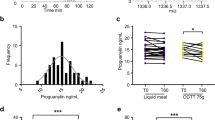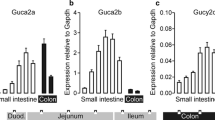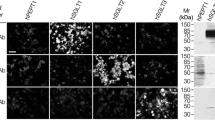Abstract
In order to examine the intestinal expression of the recently cloned H+/di-tripeptide transporter (PepT1), oligonucleotide probes were synthesized and their specificity confirmed by Northern blot analysis of rabbit jejunal RNA. In situ hybridization studies, using these probes, show that PepT1 is expressed all along the small intestine and at a very much reduced level in the colon. In contrast, PepT1 mRNA was not detected in the stomach, sacculus rotundus or caecum. Microscopic examination of tissue sections showed PepT1 expression to be restricted to intestinal epithelium with no detectable expression in the lamina propria, muscularis mucosae, muscularis or serosa. The accumulation of PepT1 mRNA along the crypt-villus axis was also investigated. In all regions of the small intestine (in duodenum, jejunum and ileum), PepT1 mRNA was undetectable in deeper epithelial cells of the crypts. Expression was first detectable at or near the crypt-villus junction, the amount of PepT1 mRNA increasing rapidly in the lower villus to a maximum approximately 100–200 μm from this point. Along the length of the small intestine PepT1 mRNA was most abundant in duodenal and jejunal enterocytes, with lower levels in the ileal epithelium. PepT1 expression is greatly depressed in the follicle-associated epithelium of the Peyer's patch relative to both interfollicular and adjacent “normal” villi. These data are discussed in the context of the known physiological role of PepT1 in the gastrointestinal tract.
Similar content being viewed by others
References
Abe M, Hoshi T, Tajima A (1987) Characteristics of a transmural potential change associated with the proton-peptide co-transport in toad small intestine. J Physiol (Lond) 394: 481–499
Boll M, Markovich D, Weber WM, Korte H, Daniel H, Murer H (1994) Expression cloning of a cDNA from rabbit small intestine related to proton-coupled transport of peptides, beta-lactam antibiotics and ACE inhibitors. Pflügers Arch 429: 146–149
Cheeseman CI (1986) Expression of amino acid and peptide transport systems in rat small intestine. Am J Physiol 251:G636-G641
Chirgwin JM, Pzybyla AE, MacDonald RJ, Rutter WJ (1979) Isolation of biologically active ribonucleic acid from sources enriched in ribonuclease. Biochemistry 18:5294–5299
Daniel H, Fett C, Kratz A (1989) Demonstration and modification of intervillus pH profiles in rat small intestine in vitro. Am J Physiol 257:G489-G495
Fei YJ, Kanai Y, Nussberger S, Ganapathy V, Leibach FH, Romero MF, Singh SK, Boron WF, Hediger MA (1994) Expression cloning of a mammalian proton-coupled oligopeptide transporter. Nature 368:563–566
Ferraris RP, Diamond J, Kwan WW (1988) Dietary regulation of intestinal transport of the dipeptide carnosine. Am J Physiol 255:G143-G150
Freeman TC, Collins AJ, Heavens RP, Tivey DR (1993) Genetic regulation of enterocyte function: a quantitative in situ hybridization study of lactase-phlorizin hydrolase and Na+-glucose cotransporter mRNAs in rabbit small intestine. Pflügers Arch 422:570–576
Freeman TC, Howard A, Bentsen BS, Legon S, Walters JRF (1995) Cellular and regional expression of transcripts of the plasma membrane calcium pump PMCA1 in rabbit intestine. Am J Physiol (in press)
Ganapathy V, Leibach FH (1985) Is intestinal peptide transport energized by a proton gradient? Am J Physiol 249: G153-G160
Hidalgo IJ, Ryan FM, Marks GJ, Smith PL (1993) pH-dependent transepithelial transport of cephalexin in rabbit intestinal mucosae. Int J Pharm 98:83–92
Mason C, Jepson MA, Simmons NL, Hirst BH (1994) Heterogeneous expression in the epithelia of rabbit gut-associated lymphoid tissues. Pflügers Arch 427:343–347
Matthews DM, Adibi SA (1976) Peptide absorption. Gastroenterology 71:151–161
McEwan GTA, Daniel H, Fett C, Burgess MN, Lucas ML (1988) The effect of Escherichia coli STA enterotoxin and other secretagogues on mucosal surface pH of rat small intestine in vivo. Proc R Soc Lond [Biol] 234:219–237
Minami H, Morse EL, Adibi SA (1992) Characteristics and mechanism of glutamine-dipeptide absorption in human intestine. Gastroenterology 103:3–11
Rawlings JM, Lucas ML, Russell RI (1987) Measurement of jejunal surface pH in situ by plastic pH electrode in patients with coeliac disease. Scand J Gastroenterol 22:377–384
Rubino AM, Guandalini S (1977) Dipeptide transport in the intestinal mucosae of developing rabbits. Ciba Found Symp 50: 61–71
Savidge TC, Smith MW, Mayel-Afshar S, Collins AJ, Freeman TC (1994) Selective regulation of epithelial gene expression in rabbit Peyer's patch tissue. Pflügers Arch 428:391–399
Shimada T (1987) Factors affecting the microclimate pH in rat jejunum. J Physiol (Lond) 392:113–127
Smith MW, Turvey A, Freeman TC (1992) Appearance of phloridzin sensitive glucose transport is not controlled at mRNA level in rabbit jejunal enterocytes. Exp Physiol 77:525–528
Thwaites DT, Brown CDA, Hirst BH, Simmons NL (1993) Transepithelial Gly-Sar transport in intestinal Caco-2 cells mediated by expression of H+-coupled carriers at both apical and basal membranes. J Biol Chem 268:7640–7642
Thwaites DT, McEwan GTA, Hirst BH, Simmons NL (1993) Transepithelial dipeptide (glycylsarcosine) transport across epithelial monolayers of human Caco-2 cells is rheogenic. Pflügers Arch 425:178–180
Author information
Authors and Affiliations
Rights and permissions
About this article
Cite this article
Freeman, T.C., Bentsen, B.S., Thwaites, D.T. et al. H+/Di-tripeptide transporter (PepT1) expression in the rabbit intestine. Pflügers Arch 430, 394–400 (1995). https://doi.org/10.1007/BF00373915
Received:
Revised:
Accepted:
Issue Date:
DOI: https://doi.org/10.1007/BF00373915




